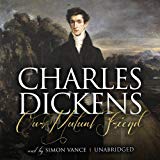
One of the most prevalent symbols in Our Mutual Friend is that of the River Thames, and the river is linked to major themes of the novel, rebirth and renewal. Water is seen as a sign of new life, and associated by the Christian Church with the sacrament of Baptism. Characters like John Harmon and Eugene Wrayburn end up in the waters of the river, and come out reborn as new men. Wrayburn emerges from the river on his deathbed, but is ready to marry Lizzie to save her reputation. He surprises everyone, including himself, when he survives and goes on to have a loving marriage with Lizzie. John Harmon also appears to end up in the river through no fault of his own, and when Gaffer pulls his "body" out of the waters, he adopts the alias of John Rokesmith. This alias is for his own safety and peace of mind; he wants to know that he can do things on his own, and does not need his father's name or money to make a good life for himself.
Throughout Our Mutual Friend , Dickens uses many images that relate to water. Phrases such as the "depths and shallows of Podsnappery," and the "time had come for flushing and flourishing this man down for good", are examples of such imagery. Some critics see this as being used excessively
In Our Mutual Friend Dickens also explores the conflict between doing what society expects of a person and the idea of being true to oneself. Much of what society expects of a person may be shown through the influence of their family. In many of Dickens's novels, including Our Mutual Friend and Little Dorrit , parents try to force their children into arranged marriages, which, although suitable in terms of money, are not suitable in other ways. John Harmon, for example, was supposed to marry Bella to suit the conditions of his father's will, and though initially, he refused to marry her for that reason, he later married her for love. Harmon goes against his father's wishes in another way too, simply by taking the alias of John Rokesmith. By taking this new identity, he refuses his inheritance. Bella is also swayed by the influence of her parents. Her mother wishes her to marry for money to better the fortunes of the entire family, although her father is happy with her marrying John Rokesmith for love. Bella's marriage to Rokesmith goes against what is expected of her by her mother, but eventually her mother accepts the fact that Bella has at least married someone who will make her happy. However, later on in the novel, Bella accepts the everyday duties of a wife, and seemingly gives up her independence. Yet she refuses to be the "doll in the doll's house"; and is not content with being a wife who rarely leaves her home without her husband. Furthermore, Bella reads up on the current events so that she can discuss them with her husband, and is actively involved in all of the couple's important decisions.
Lizzie Hexam also objects to her marriage to Eugene Wrayburn. She does not aspire to marrying Wrayburn even though she loves him and would be elevated in society simply by marrying him, which almost any woman would have done at the time. Lizzie feels that she is unworthy of him. Wrayburn, however, feels that he is unworthy of such a good woman. He also knows that his father would disapprove of her low social status. Therefore, both of them end up going against expectations by marrying each other.
Lizzie also ends up going against her brother Charley's wishes, when she refuses to marry Bradley Headstone. He would have been an excellent match for her, according to norms of the time, however, Lizzie does not love him. She unselfishly does what others expect of her, doing things like helping Charley escape their father to go to school, and living with Jenny Wren. Marrying Wrayburn is the only truly selfish act Lizzie commits in Our Mutual Friend , and even that is debatable, since she only did it because Wrayburn appeared to be on his deathbed.
Already have an account? Log In Now